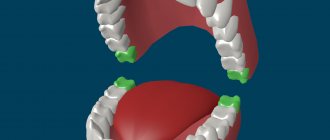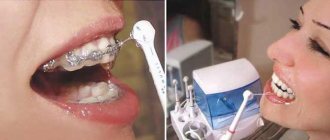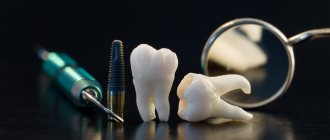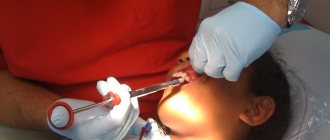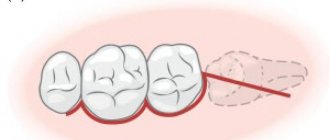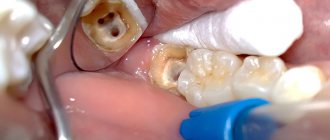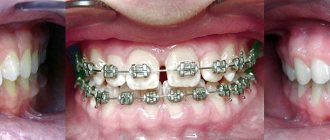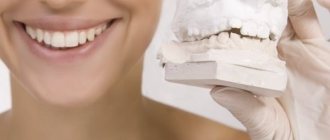2367
In some cases, the installation of orthodontic structures to correct the bite requires the preliminary removal of teeth.
It is important to know whether this need always arises, and in what cases it is possible to do without surgical intervention.
Introduction to Corrective Systems
Devices for correcting defects in bite and occlusion, or braces, are unique designs that are fixed to one or two rows of teeth.
The systems consist of locks (plates), which are fixed to the teeth using special glue, and a metal arch fixed in the grooves of the locks.
Due to the correctly calculated pressure of the arc on the teeth, they gradually shift until they take the correct position and the bite is corrected.
The setting of these structures is shown:
- When eliminating diastemas, that is, significant gaps between the first incisors;
- For better cutting of some units;
- When eliminating deformation of the dentition as a result of the loss of individual units;
- When eliminating complex defects of the jaw arches.
Before installing the devices, it is necessary to carry out a number of preparatory measures:
- Diagnostics. This stage includes an examination by the orthodontist, an orthopantomogram, that is, the creation of a circular projection of the row.
- Making impressions. Impressions of the patient's jaws are taken and plaster models are made. All these manipulations are carried out to identify pathologies and further select the system necessary for the patient.
- Sanitation. It includes treatment of teeth and gums. Since the systems are installed for a long time, their installation is impossible if inflammatory processes occur in the oral cavity.
- Extraction of individual units. This procedure is indicated if some units interfere with adequate treatment.
The last stage is not always a mandatory procedure; its implementation is indicated by certain indications.
What documents do you need to collect to get a tax deduction for your child’s braces?
Come here to find out who can get braces for free under compulsory medical insurance.
At this address https://orto-info.ru/sistemyi-vyiravnivaniya-zubov/breketyi/ormco.html we will consider in detail the designs of Ormco braces.
What are 5 teeth for?
In dentistry, fifth teeth are called second premolars, and fourth teeth are called first premolars. They are responsible for intermediate chewing of food and are the connecting link between the front and chewing teeth. If you look at such teeth from the side, they may resemble fangs - rather elongated and narrow, but from above the premolar is very different from the canine. It has a platform for chewing food, just like molars.
Despite the fact that the fifth and fourth teeth belong to the same group and even perform the same function, in dentistry they are very different. The fact is that fours belong to the smile zone, they are always in sight and are very important from an aesthetic point of view. The second premolars are practically invisible to others, although they are located in close proximity to the front teeth.
Indications for extraction
If possible, dentists try to avoid removing teeth, especially healthy ones, but in some cases this is the only right decision:
- with a strong degree of curvature of the dentition;
- if there is a discrepancy between the size of the jaw and the number of teeth;
- if there is a discrepancy between the sizes of the upper and lower jaws;
- if there are too large units;
- with a significant violation of facial proportions;
- in the presence of thoroughly destroyed units that cannot be restored.
Which units need to be removed before installing an orthodontic structure is decided after a thorough diagnosis.
Number of roots and canals in human teeth
Most of the oral cavity is occupied by organs whose main function is to chew and grind food into smaller pieces. This promotes its complete digestion and better absorption of nutrients. A tooth is an organ that has a characteristic shape and consists of several parts. In dentistry, the outer visible part is called the crown, and the inner part is called the root. The element connecting the crown and root is the neck.
Read also: Is a tooth removed during gumboil?
An interesting fact is that, unlike a crown, a tooth can have more than one root. How many roots a tooth has, as a rule, depends on the location and purpose of the organ. In addition, its structure and number of roots are influenced by hereditary factors. The situation can only be definitively clarified with the help of an x-ray.
The article provides detailed information about how many roots there are in the frontal, lateral chewing teeth, as well as the number eight, or the so-called wisdom tooth. In addition, you can find out what the purpose of the tooth root is, why the chewing units need nerves. The dental advice provided in the following material will help prevent the development of dental diseases.
Disposable units
During the examination, X-ray images are used, with the help of which the orthodontist decides which units will create a significant obstacle when correcting the bite.
Wisdom teeth extraction
The need to extract figure eights when installing braces is a controversial issue.
In some cases, it is recommended to get rid of them in order to achieve maximum effect in correcting the bite. This issue is resolved taking into account the position of the eights and their condition.
The abnormal placement of eights can interfere with the restoration of the normal position of other units in the series.
A particular problem is caused by impacted eights, that is, those that have not yet erupted. They must be removed before installing braces, since when they erupt, they can provoke a row shift during or after bite correction.
If the figure eight is significantly destroyed as a result of caries or pulpitis, its removal is also indicated.
There is an opinion that before installing the systems, the eights must be removed, even if they occupy the correct position in the row and are not subject to destruction.
This position is justified by several arguments:
- Minor role in the chewing process.
- Weak roots. After installing braces, the figure eights cannot withstand the pressure of the structure.
According to another opinion, if a carious wisdom tooth can be cured, and its location does not interfere with the effective correction of the bite, extraction is not resorted to.
The need to remove premolars
Premolars are teeth located in the fourth and fifth positions in the row. When correcting the bite, they can be removed to make room for the alignment of crowded elements.
Extraction is also carried out for the following reasons:
- have relatively small sizes;
- perform a small chewing load compared to other units.
Premolar extraction surgery is indicated in a number of cases:
- Significant degree of crowding of teeth in a row.
- High amplitude of deployment.
- Moving the lower jaw forward.
- Distal occlusion, that is, a strong protrusion of the upper jaw relative to the lower jaw.
- Cross occlusion, that is, the position of the teeth in which they cross when the jaws close.
Front teeth extraction
Frontal teeth are the least frequently removed. Their preservation is preferable for a number of reasons:
- Influence on human aesthetics and diction.
- Important role in the structure and position of the jaws.
- When removed, the facial profile may change.
As a rule, extraction of these units is carried out when the patient has a mesial occlusion. The anomaly is characterized by a significant protrusion of the lower jaw forward relative to the upper jaw.
Review of popular models of American Orthodontics braces and main characteristics of the products.
In this publication we will tell you how to remove glue from teeth after braces.
Here https://orto-info.ru/sistemyi-vyiravnivaniya-zubov/breketyi/dlya-podrostka-skolko-stoyat-i-tsena-lecheniya.html we will calculate how much it costs to get braces for a teenager.
Is it painful to remove the 5th tooth?
Today, any more or less complex dental operation is performed under anesthesia, which eliminates any pain. Most often, local anesthetics are used, which are introduced into the body by injection into the gum area.
Painkillers act only on the required area and do not in any way affect the functioning of the body as a whole, so we can talk about the comparative safety of this method of anesthesia. It is even used in dental treatment for pregnant women and children. Even if we compare the removal of the second premolar with a similar operation on other teeth without taking into account anesthesia, it can still be called quite simple and painless. The root system of fives is not as developed as, for example, that of molars, and the shape of the crown allows it to be firmly grasped with forceps. All these factors together allow the dentist to perform the operation as efficiently as possible, but at the same time very quickly.
Expected effect
When correcting the bite using orthodontic systems, tooth extraction makes it possible to speed up and facilitate the process of changing the position of the teeth.
The movement mechanism consists of the following actions:
- Due to the pressure that the device exerts on the units, the hole expands.
- The connective tissue is stretched.
- New bone cells are formed in the free area.
Thus, the units are moved to the row space that was freed up by removing individual elements.
After surgery, the main correction period is significantly reduced by about two months. This is especially true in cases where the patient has crowded teeth.
The gaps created by extraction are closed approximately six months after the start of therapy.
In some cases, after correction, the patient’s facial features change. As a result of bite correction, the face becomes more symmetrical.
Consequences
This aspect is worth dwelling on in more detail. What complications can come from removing an upper wisdom tooth? The consequences of such an operation can be quite unpleasant. Swelling, pain, bleeding after such an intervention are mandatory companions. But other complications may also develop.
These include:
- Fracture of an adjacent tooth: this type of damage usually occurs due to improper use of surgical instruments, as well as lack of practice by the doctor.
- Breakage of the upper part of a tooth or root during extraction: this complication most often occurs when a tooth damaged by caries is captured with forceps. Experienced doctors usually do not make this mistake.
- Damage to the gum mucosa: an inevitable complication during tooth extraction surgery. Soft tissues are very sensitive to any physical influence. Due to the difficult-to-reach location of a wisdom tooth, when removing it, the instrument often slips and causes damage to the oral cavity.
- Perforation of the stump of the maxillary sinus: when an image is taken before surgery, this complication usually does not occur.
- Fever: Body temperature may increase by 1 degree after wisdom tooth removal. This is considered a normal reaction of the body. However, if the fever persists for more than 12 hours, you should consult a doctor. This symptom may be a sign of an infection developing.
- Bleeding: To avoid post-operative bleeding, it is recommended to refrain from visiting saunas and steam rooms for a while. Also, while the wound is healing, it is recommended to reduce physical activity to a minimum and not consume alcohol and tobacco.
- Hematoma: usually appears during the administration of anesthesia. If this symptom is accompanied by an increase in temperature, you should seek help from a doctor.
- Swelling: the most common complication of wisdom tooth removal. If it is accompanied by fever, purulent odor and pain, you should seek medical help.
In most cases, the likelihood of complications depends on the professionalism of the dentist, as well as on the individual characteristics of the patient. If you use all the recommendations after removing the upper wisdom tooth, you can reduce the likelihood of unpleasant consequences and complications. You can find a competent specialist based on various reviews, as well as on the advice of friends. The best way to maintain the health and beauty of your teeth is to undergo a timely preventive examination.
Is it possible to do without surgery?
Minor defects in bite and occlusion may preclude extraction:
- crowding of two or four elements;
- abnormal bite with normal size and shape of the elements of the jaw arches;
- weak protrusion of one jaw forward relative to the other;
- no significant forward tilt of the units;
- There is no interference when closing the lips.
Removal is carried out solely according to indications, and in cases where none of the more gentle methods has produced results.
Separation efficiency
Many dentists recommend replacing tooth extraction with separation, which is a more gentle treatment option. This is a procedure in which a small layer of enamel is removed from the sides of problem units.
After separation, the space that is missing for the optimal placement of all elements in the jaw row is freed up.
The following tools are used for the procedure:
- strips, that is, special strips with an abrasive surface;
- fine-grained burs.
They allow you to remove a layer of enamel as accurately and safely as possible for the integrity of hard dentin tissue.
Particular attention is paid to a specially developed technique called physiological separation. It consists of installing separation wedges between individual units.
A day after fixing the wedges or separation rings, a gap forms between the teeth. Subsequently, the movement of those elements that were out of place will occur.
This procedure has a number of advantages:
- Allows you to avoid extraction of healthy teeth.
- Makes it possible to get rid of gaps between teeth in the base area.
- Since most often the teeth are trapezoidal in shape, wide at the top and narrower at the bottom, after moving they acquire a rectangular shape, and the gaps between them close.
Separation is considered a simple procedure that does not cause harm. A very thin layer of enamel is removed, amounting to only a quarter of a millimeter, and as a result the integrity of the dentin is not compromised.
One of the most important disadvantages of this technique is the increase in tooth sensitivity. However, after separation, procedures are carried out to strengthen the enamel, which prevent its further thinning.
Prices for services
Extraction prices depend on the location of the unit and the complexity of the procedure. The table below shows approximate prices for such an operation.
| Unit type | Easy removal | Difficult removal |
| cutter | 700 – 800 rubles | from 1000 rubles |
| molar | 800 – 900 rubles | from 1200 rubles |
| eight | 900 – 1000 rubles | from 1400 rubles |
Complex removal means extraction, during which it is necessary to carry out additional manipulations, for example, opening the gums and applying sutures. For complex removal, the cost of the service is calculated individually.
As for separation, the cost of this service depends on the number of units that need to be processed. The average price is 500 – 600 rubles per unit.
In the video, a specialist clearly explains whether teeth need to be removed before installing braces.
How is the 5th tooth removed?
The operation is carried out in several stages. I would like to note right away that it is planned, which makes it possible to prepare the patient for it in advance. First, the dentist recommends treating all infectious diseases, such as caries, and having your teeth professionally cleaned. These measures minimize the chance of harmful bacteria entering an unprotected hole. If necessary, the patient will have to undergo tests. It is especially advisable to do this if it is his first time dealing with anesthesia; he may have a dangerous allergy, the existence of which he might not even suspect. The operation itself is very simple. After introducing the anesthetic into the body, the dentist grabs the tooth with forceps, gently loosens it and pulls it out of the socket. The wound is treated with an antiseptic and covered with a gauze pad.
Read also: Is it painful to remove a tooth?
If the operation was performed under local anesthesia, the patient can go home within a few minutes after its completion. The painkillers will last a couple of hours, which will affect facial expressions. Further, the success of treatment depends only on the patient himself. He must follow a whole set of rules to avoid unpleasant consequences.

